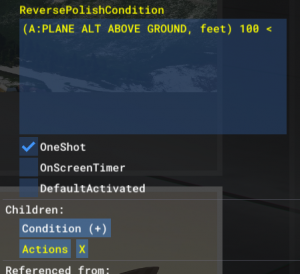Porting FSX Missions to MSFS
| This page is a work-in-progress. Generic message - Please note some detail may possibly be missing or incorrect. |
| Applicable |
|---|
| MSFS2024 |
| MSFS2020 |
| MS Flight |
| LM P3D5 |
| LM P3D4 |
| LM P3D3 |
| LM P3D2 |
| LM P3D |
| FS World |
| FSXSE |
| FSXA |
| FSX |
| FS2004 |
| FS2002 |
| XP11 |
| XP10 |
| XP9 |
You can open FSX mission scripts in MSFS. You can find the .xml files in Mission Samples in the FSX SDK. Or you can use the fsx spb2xml tool to convert the .spb in the mission folder.
Steps
Just make a mission project in msfs like normal. Copy the sounds folder if you want. Open the script editor. File>Open, open the fsx .xml. If it doesn't load, look in the console for a xml error.
This will point to a specific part that isn't recognized. This means that part is not supported, so you have to delete it manually from the .xml . Keep in mind that you may have to replace this with a modern alternative later. When the script loads without error, you will see that all nodes are centered (because FSX had a different script editor):
You will have to move the nodes to create a clear structure for yourself. I prefer to first seperate all unconnected parts:
Remember to save frequently and make regular backups.
And then I sort them in roughly chronological order (you can use the numbers of the dialog and a video or your memory of the mission):
Then I add comments to make the mission easier to understand:
Now that we have a better idea of the mission, we can change some of the things that don't port over accurately.
Updating Area rotation
In FSX, the rotation of areas was defined in the Area node itself, but now it has moved to the AttachedWorldPosition. So we need to move the rotation data. For every area and axis: - Copy the rotation for the axis (e.g. Head). - Change it to 0 in the Area node. - Go to AttachedWorldPosition and paste the rotation.
You may also have to change the position of areas at the airport, because the data may have changed.
Updating Property Triggers
PropertyTriggers used to have a child with the condition of the trigger. This has changed to a ReversePolishCondition in MSFS. Just click on the child condition. You will see the type like LessThan or Equal. If you click on it you will see LHS (left hand side) and RHS (right hand side). Remember the values. In the ReversePolishCondition, first fill in the LHS, then the RHS, and then the type.
You have to use C# operators like > and !=. Instead of, for example Simvar.AltitudeAGL you will have to use the new notation: (A:PLANE ALT ABOVE GROUND, feet).
Then remember remove the old child condition. Overall it will look like this:
LibraryObject
The old references to FSX LibraryObjects won't work, because the objects are not included in msfs. You can add a modellib to your mission package, that contains the models you need. Then you can reference them with the GUID.
SimObjects
AI planes will need to be updated with an MSFS airplane in the script (.xml) and flight file (.FLT). The AI may also need to be remade.
Flight file (.FLT):
FSX → MSFS
Script file (.xml):
FSX → MSFS
Example
You can see an example by downloading the project files of my Caribbean landing port.
- Flightplan
- Weather definitions
- Flight file
- Mission script
- Triggers
- Actions
- ObjectActivationAction · DialogAction · AdjustPayloadAction · ChangeAssistanceItemAction · FadeToColorAction · RandomAction · RequestTeleportAction · CountAction · ResetTimerAction · TimerAdjustAction · GoalResolutionAction & SubGoalResolutionAction · GrantRewardAction · PointOfInterestActivationAction · ActivateWaypointsAction · AITakeControlsAction · SendMessageToAIAction
- Mission objects
- Calculator
- Flow states
- Events
- Areas
- Library objects
- Sim objects
- RTC








